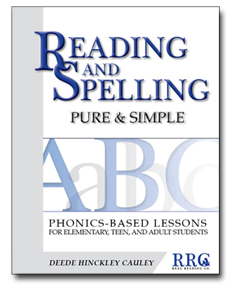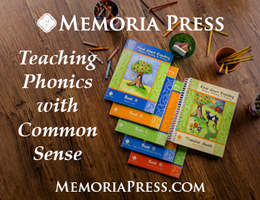Reading and Spelling Pure & Simple really is a simple-to-use reading program. It is contained within one large book that can be used with young students just beginning to learn to read as well as for older students, even adults, who have struggled with reading. Introductory pages at the beginning explain the program fairly briefly.
The program itself is presented in four units plus a “Pre-Unit.” You will use the Pre-Unit if you need to introduce children to the alphabet, the sounds of the letters, the concept of reading left to right, and/or initial blending. The Pre-Unit has only five lessons, but the first part where you will introduce individual letters and sounds actually takes place prior to the first of these lessons and might take weeks or months depending upon the ability of each child. Lessons A through E then teach blending, reading, and spelling of one-syllable words with short a. Since students begin to write as they work in Lesson A, you will need to provide handwriting instruction on you own, possibly right alongside these lessons.
The next four units have a total of 90 lessons. Each lesson takes up only two pages. (Occasionally two lessons are squeezed onto only two pages.) For each lesson the left-hand page has instruction and notes for the teacher. The right hand page has groups of words listed next to Roman numerals—there are four to six groups of words per page. Each group should be completed before tackling the next group. You might need to work on one group for a few days before going on to the next.
Lessons follow a consistent format all the way through the book with four steps used as you work through each group of words. First, you will help students learn to read each word, sounding out letters and reading aloud. Next, you will discuss the meanings of words so that students read with understanding. Keep a dictionary on hand to look up words as needed. For the third step, you will dictate these words to the student, and they will write them down. (Students should probably maintain a notebook to be used exclusively for this course.) Students will practice spelling and writing these words until they can write them quickly and accurately. Many lessons have a few additional “challenge words” in a box following the groups of words. These help introduce students to compound words and multi-syllable words. The final step is to mark one of the progress charts.
Progress charts are provided in a few formats. An older student might work quickly through the lessons, and the simpler progress chart where you mark only completed lessons might be best. If you work more slowly through the groups of words you might want to use the detailed charts where you can record progress through each group of words. Both versions allow you to record student success in reading as well as spelling.
The curriculum was written such that it can be taught in many situations with minimal teacher preparation. The teacher should read through each lesson’s instructions before they begin, but this should take only about five minutes. Lessons follow an orderly phonetic progression. Unit 1 teaches short-vowel words. Unit 2 teaches long-vowel word plus /ü/. Unit three teaches additional phonograms, multi-syllable words, compound words, suffixes, and the schwa. Unit 4 continues with homophones, homonyms, homographs, contractions, irregular words, and other topics such as the six possible spellings for the /k/ sound.
The program will have covered the essentials of phonics at this point. Words typically taught as sight words are incorporated into the lessons. For example, the word two is taught along with words such as wrap, wrong, and answer as words with a silent w. This is an interesting approach that encourages students to think more about patterns than simply memorizing unusual words as sight words.
You might have noticed that nowhere have I mentioned reading sentences or paragraphs. This program intentionally teaches words in isolation. The author wants students to concentrate on the meanings of individual words as well as the way they are spelled. Her experience is that students find the challenge of reading, spelling, and writing the words motivating enough that they don’t mind the delay for reading sentences or stories. After the final lesson, the teacher is to select a book that the student will then work on reading aloud. At that point, you will still need to instruct a student how to read punctuation—that a comma means pause, that a period means stop, etc.
There are no pictures aside from pictures for introducing initial sounds of the letters. These are used only at the beginning as needed. The idea is to avoid students guessing based upon pictures.
While the program should be easy to teach, the teacher needs to interact with the student rather than only reading what’s written in the book. If a student struggles, the teacher needs to help them work through whatever is hanging them up. But the author urges teachers to keep the atmosphere relaxed and comfortable rather than pressured. Reading and Spelling Pure & Simple has been used in very diverse settings, and I suspect it might be best for older students who have struggled with reading. While you can use it with young, beginning readers, you might be tempted to move too quickly through the Pre-Unit since the amount of activity spelled out for you in the lessons is minimal. However, if you have a student who knows the sounds of the letters, knows how to write the letters, and grasps the concept of blending, this might be a very efficient reading program for you.











